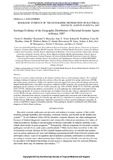| dc.description.abstract | Diseases of zoonotic origin contribute to the burden of febrile illnesses in developing countries. We evaluated serologic evidence of exposure to Bacillus anthracis, Brucella spp., spotted fever group rickettsioses (SFGR), and typhus group rickettsioses (TGR) from samples of persons aged 15-64 years collected during a nationwide human immunodeficiency virus (HIV) serosurvey conducted in 2007 in Kenya. The seropositivity observed for pathogens was B. anthracis 11.3% (141/1,091), Brucella spp. 3.0% (27/968), SFGR 23.3% (191/770), and TGR 0.6% (12/770). On univariate analysis, seropositivity for each pathogen was significantly associated with the following risk factors: B. anthracis with province of residence; Brucella spp. with sex, education level, and wealth; SFGR with age, education level, wealth, and province of residence; and TGR with province of residence. On multivariate analysis, seropositivity remained significantly associated with wealth and province for B. anthracis; with sex and age for Brucella spp; and with sex, education level, and province of residence for SFGR whereas TGR had no significance. High IgG seropositivity to these zoonotic pathogens (especially, B. anthracis and SFGR) suggests substantial exposure. These pathogens should be considered in the differential diagnosis of febrile illness in Kenya. | en_US |

